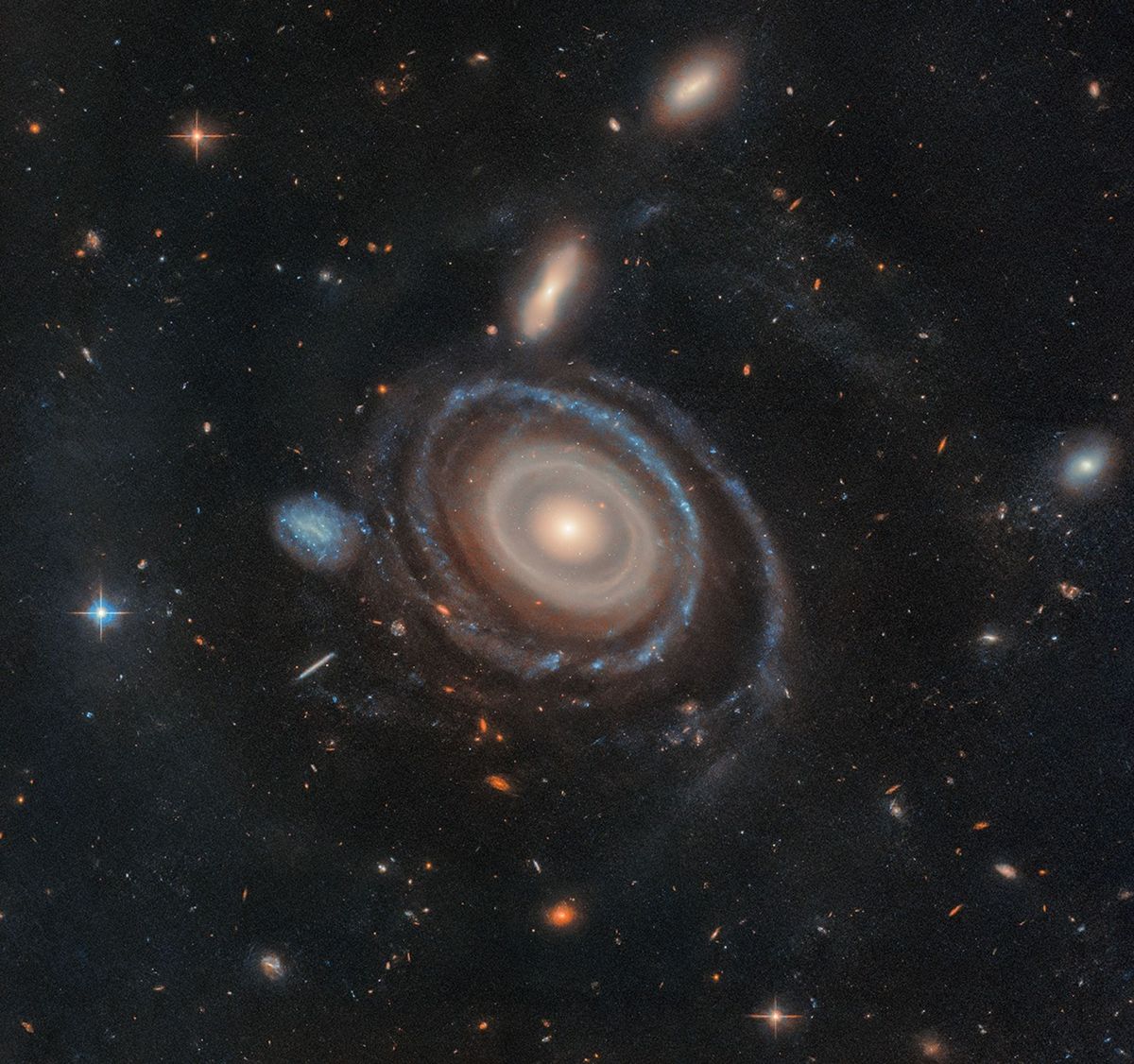
:focal(1922x1812:1923x1813)/https://tf-cmsv2-smithsonianmag-media.s3.amazonaws.com/filer_public/74/4f/744f3fa5-a6bd-4987-b4eb-4c6dbb9ee3c9/bullseye_galaxy_next_to_blue_dwarf_galaxy.jpg)
LEDA 1313424, nicknamed the Bullseye, appears next to the small blue dwarf galaxy on its immediate left.
NASA, ESA, Imad Pasha (Yale), Pieter van Dokkum (Yale)
Around 50 million years ago, a blue dwarf galaxy shot through the center of an enormous galaxy more than twice the size of the Milky Way, called LEDA 1313424. Now, astronomers have revealed the spectacular result of this record-breaking collision: nine starry rings, which is six more than any other galaxy known to scientists.
LEDA 1313424 was appropriately dubbed the “Bullseye,” as detailed in a study published Tuesday in The Astrophysical Journal Letters.
NASA’s Hubble Space Telescope detected eight of those rings, and data from the W. M. Keck Observatory in Hawaii confirmed a ninth. The team also suspects the collision might have formed a bygone tenth ring. In the words of Forbes’ Amanda Kooser, “the smaller galaxy not only put a ring on it, it put at least nine rings on it.”
The blue dwarf galaxy (seen on LEDA 1313424’s left in the image) shot through the Bullseye like an arrow. The impact moved material both inward and outward and triggered new regions of stellar formation, creating ripples akin to when you drop a pebble in water. Over time, the galaxy’s stars “piled up” into rings. Now, the blue dwarf galaxy has fled 130,000 light-years away from its victim.
“We’re catching the Bullseye at a very special moment in time,” Pieter G. van Dokkum, an astronomer at Yale University and a co-author of the new study, says in a statement from NASA. “There’s a very narrow window after the impact when a galaxy like this would have so many rings.”
In approximately four billion years, scientists predict that our Milky Way will crash into the Andromeda Galaxy—our closest galactic neighbor—but that will be a more complex collision than the one recently highlighted by Hubble, per Universe Today’s Alan Boyle. In fact, collisions involving one galaxy diving through the center of another are exceptionally rare.
An illustration compares the size of our own Milky Way to LEDA 1313424. NASA, ESA, Ralf Crawford (STScI)/https://tf-cmsv2-smithsonianmag-media.s3.amazonaws.com/filer_public/69/4f/694f5948-8459-478d-9f6b-daf1c79376c2/milky_way_bullseye_comparison.jpg)
The Bullseye had another revelation in store. Imad Pasha, the study’s lead author and an astronomer at Yale, discovered the gargantuan galaxy’s rings rippled out almost exactly the way previously developed models would have predicted.
“It is immensely gratifying to confirm this long-standing prediction with the Bullseye galaxy,” van Dokkum says in the statement.
Hubble allowed scientists to identify the precise positioning of most of the rings, but they aren’t as evenly spaced as the galaxy’s name—or even the magnificent image itself—would suggest. The image was snapped at a slight angle, concealing the fact that numerous rings are bunched together at the center, and the inter-ring spacing grows larger on the periphery. Per the researchers, this might be because the first two rings—the ones most influenced by the collision—formed rapidly before widening, whereas the subsequent rings could have formed in a more staggered fashion.
An illustration shows the Bullseye face-on, with its rings highlighted. More of the rings are bunched together near the middle. NASA, ESA, Ralf Crawford (STScI)/https://tf-cmsv2-smithsonianmag-media.s3.amazonaws.com/filer_public/92/7b/927b0f30-e4f5-41f1-8bda-3408ea4eb6a0/bullseye_rings.jpg)
“Hubble can see more rings than previous observations because of its higher spatial resolution: That allows us to see separations between rings that in ground-based observations are blurred together in a single ring,” van Dokkum explains to Gizmodo’s Isaac Schultz.
Moving forward, NASA’s forthcoming Nancy Grace Roman Space Telescope—an observatory planned for launch no earlier than October 2026—will help astronomers find even more galaxies. With more data, they hope to refine their idea of just how rare this sort of astronomical collision truly is.







